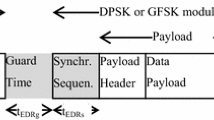Abstract
This paper presents the results of a coexistence study investigating the impact of ultra-wideband (UWB) interference on IEEE 802.11b and Bluetooth networks. The results are based on the experimental test measurements made at the University of Oulu, Finland. Simple high-power UWB transmitters are used to interfere with victim networks. Preliminary results show that only under extreme interference conditions with thousands of equivalent Federal Communications Commission– (FCC)-compliant devices in close proximity, will the IEEE 802.11b and Bluetooth networks experience significant performance degradation. The impact of the UWB interference on the IEEE 802.11b network was insignificant if the distance to UWB transmitters was greater than 40 cm. The impact on Bluetooth was even less noticeable. In our study, several high-power UWB transmitters that greatly exceed the FCC radiation regulations have been used, and the measurement settings presents the worst case scenario because of the very short distance between the interferers and the victim system. Effectively our study approximates the use of thousands of FCC-complaint UWB devices in the same space.
Similar content being viewed by others
References
http://grouper.ieee.org/groups/802/11/. Accessed Sept 4, 2003.
http://www.bluetooth.com/dev/specifications.asp. Accessed Sept 4, 2003.
S. Choi, S. Cho, and H. Lee, UWB interference test in IEEE802.11b WLAN environment, Proceedings of the 2003 International Workshop on Ultra-Wideband Systems, June 2–5, 2003, Oulu, Finland.
M. Jang, S. Choi, and H. Lee, Experimental study on 802.11b DSSS WLAN performance with UWB device, Proceedings, of the 2003 International Workshop on Ultra-Wideband Systems, June 2–5, 2003, Oulu, Finland.
M. Hämäläinen, J. Saloranta, J.-P. Mäkelä, I. Oppermann, and T. Patana, Ultra-wideband signal impact on IEEE802.11b and Bluetooth performances. The 14th International Symposium on Personal, Indoor and Mobile Radio Communications, Peking, China, 2003.
M. Hämäläinen, J. Saloranta, J.-P. Mäkelä, I. Oppermann, and T. Patana, UWB impact on IEEE802.11b wireless local area network, The 6th International Symposium on Wireless Personal Multimedia Communications, Yokosuka, Japan, 2003.
Federal Communications Commission, First report and order in the matter of revision of part 15 of the commission's rules regarding ultra-wideband transmission systems, ET Docket 98–153, FCC 02–48, released April 22, 2002.
J. S. Lee, C. Nguyen, and T. Scullion, New uniplanar sub-nanosecond monocycle pulse generator and transformer for time-domain microwave applications, IEEE Transactions on Microwave Theory and Techniques, Vol. 49, pp. 1126-1129, 2001.
http://www.pcausa.com/Utilities/pcattcp.htm. Accessed July 3, 2003.
http://mgen.pf.itd.nrl.navy.mil/. Accessed July 3, 2003.
Author information
Authors and Affiliations
Rights and permissions
About this article
Cite this article
Hämäläinen, M., Saloranta, J., Mäkelä, JP. et al. Ultra-Wideband Signal Impact on the Performances of IEEE 802.11b and Bluetooth Networks. International Journal of Wireless Information Networks 10, 201–210 (2003). https://doi.org/10.1023/B:IJWI.0000022051.10138.4d
Issue Date:
DOI: https://doi.org/10.1023/B:IJWI.0000022051.10138.4d




